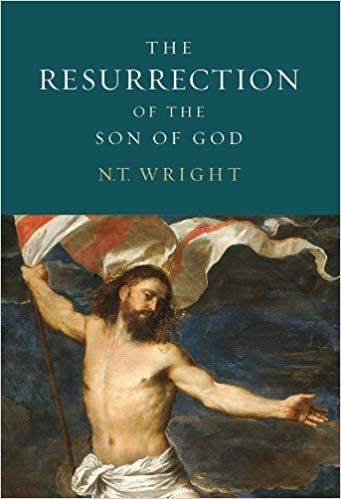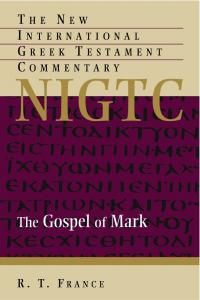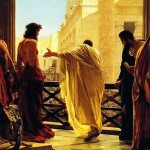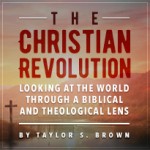Another day, another “discussion” on the Christian Twittersphere. Over the last several days, a good deal contention has erupted between Christians. As with all such social media disputes, the origin of the name-calling “debate” is a bit convoluted. As far as I can tell Broderick Greer, an Episcopal priest, fired the opening shot:
https://twitter.com/BroderickGreer/status/1034858971826479105
This was then followed up by a satirical rejoinder by author and Brazos Press editor Katelyn Beaty, the founder of Christianity Today’s Her.meneutics site, and a former managing editor of CT:
https://twitter.com/KatelynBeaty/status/1035516788879056896
This was then responded to by Greer in a series of tweets:
https://twitter.com/BroderickGreer/status/1035679311792095233
https://twitter.com/BroderickGreer/status/1035704150783389699
https://twitter.com/BroderickGreer/status/1035704152691802112
Now, lets take a pause here before following this exchange any further. Is Greer in the right here, or is Beaty? Frankly I think both make some important points. Greer is right that a lot of modern “seeker-sensitive” evangelical churches can obscure bad theology with compelling aesthetics. Prosperity gospel and quasi-prosperity gospel (this is often used by younger pastors who speak of gaining God’s “favor” by supporting them/their ministry, rather than gaining wealth) nonsense is often pushed out this way. Ditto on subjects of racial, gender, and LGBTQ issues. One need not be an open and affirming/progressive Christian to see this. I hold to a traditional view on marriage and sexuality (I am partial to the Catholic view as laid out most recently by John Paul II; but that is a topic for another time) and I am among the first to admit that all too many conservative American churches treat minority groups, especially LGBTQ people, terribly. Moving to Beaty’s tweet, I have encountered, both in writing and in person, an alarming tendency among many liberal mainline clergy to deny core creedal tenets of the Christian faith. Thankfully there are also still a good many orthodox mainliners who fully affirm the historical, bodily resurrection of Christ, several of whom I count as close friends.
But of course, as with all things related to Twitter, things just went downhill from those initial tweets. I could post more of the tweets, but you can read them for yourselves. The upshot of it all was that Greer and several other progressive mainline commenters came to the conclusion that while the creeds do affirm the bodily resurrection of Christ, this need not necessarily entail a literal bodily resurrection. Such a requirement is a modernist invention foisted upon us by the fundamentalists of the early and mid 20th century, so say Greer and company. According to one tweet, Greer proposed that the creeds were “spacious enough” to accommodate both literal and non-literal understandings of the bodily resurrection of Christ:
https://twitter.com/BroderickGreer/status/1035886889385918466
I am going to humbly propose that Greer is simply dead wrong here. Texts only gain their meaning from the historical and literary context within which they are embedded. This does not mean that texts, especially religious texts, are limited only to their historical-grammatical interpretation. Texts can bring new shades of meaning and illumination to generations of believers in very different times and contexts than those of the original author(s) and audience(s). This is why Christians can preach from the ancient texts that comprise the Old and New Testaments and still be illumined by the Spirit in the 21st century. A similar principle can apply to the Apostles’ and Nicene Creeds.
However, just because Christian texts are living, that does not mean that you can simply disregard the original historical and linguistic context of a given text, be it a creed or the Bible. The authorial intentionality of a text anchors an interpreter, allowing them to freely explore all the nuances and living elements of a text, while simultaneously guarding against anachronistic and eisegetical readings that would have made absolutely no sense to an author and/or their original historically-contextualized audience.
First, let’s start with Greer’s statements about how the emphasis on the literal bodily resurrection is a new development by fundamentalists and is not a concern of Mark’s Gospel. First off there are four gospels in total, and we look to all four as equally authoritative in regards to Jesus’ resurrection. There is a general agreement among most New Testament scholars that the Gospels fall within the general category of ancient biographies. While ancient biographies were often concerned with moral edification—and in the case of the Gospels, theology—the very nature of these texts meant that they were rooted in real, concrete historical events. They were not myths, legends, or parables. They were meant to convey historical information about Jesus of Nazareth, the Galilean prophet who performed mighty works of God, was crucified under historically dateable figures, the high priest Caiphas and the Roman prefect Pontius Pilate, both of whom are known by external Jewish and Roman historical sources, as well as archaeological data, and was resurrected from the dead. Even if Mark is utterly silent on the resurrection (it is not) we still have three other gospels, with independent eyewitness sources to Christ’s literal bodily resurrection. But I digress from my focus on Mark.
The point of this little diatribe about genre is to illustrate that, in historical and literary context, the contents of the four gospels (not just Mark) were intended by their authors to be regarded as historical; indeed, one might say as containing “literal” historical data about Jesus. That is not derived from fundamentalist reactions to 20th century liberalism, but rather from an examination of ancient historical and literary contexts within which the Gospels, particularly the Gospel according to Mark, are situated.
This brings us to the ending of Mark’s Gospel. All the way up through the narrative leading to Christ’s crucifixion, we have seen Jesus allude several times to his death and subsequent resurrection. As N. T. Wright (a fellow Anglican to Greer’s Episcopalian tradition, and not at all an American fundamentalist) puts it in his authoritative work on the subject, The Resurrection of the Son of God (Fortress, 2003):
The Markan material on resurrection comes in four reasonably obvious categories: healing, challenge, predictions (of future vindication) and puzzles (p. 404)
Wright then proceeds to examine in great detail each of these particular instances in Mark’s Gospel. Again, I could post more quotes, but I’ll let you read them for yourselves in pp. 401-29 of Wright’s book.

I’m sure some are asking at this point, “But what of the ending of Mark?! There is no explicit pronouncement of Jesus’s literal, bodily resurrection there right? What do we do with that?!” It is true that there is not a blunt verbatim statement that says, “Ok you modern people who have issues with the supernatural because you’ve imbibed a bit too much of David Hume’s erroneous and viciously circular skepticism on miracles, here it is: ‘Christ is literally bodily resurrected.’ Done.” And thank goodness. Such a modern literary diminution would make for very boring reading.
No, at the risk of being redundant, Mark is speaking within a particular historical and literary context. Thus, we have to remove our modern glasses, clouded as they are by what C. S. Lewis calls “chronological snobbery,” and enter into the world of Mark’s ancient audience. First let us look at vv. 16:1-8. I’ll use the NRSV translation to further illustrate that the emphasis upon Christ’s historically-concrete (e.g. “literal”) bodily resurrection is not a modern tenet of fundamentalist gate-keepers:
When the sabbath was over, Mary Magdalene, and Mary the mother of James, and Salome bought spices, so that they might go and anoint him. 2 And very early on the first day of the week, when the sun had risen, they went to the tomb. 3 They had been saying to one another, “Who will roll away the stone for us from the entrance to the tomb?” 4 When they looked up, they saw that the stone, which was very large, had already been rolled back. 5 As they entered the tomb, they saw a young man, dressed in a white robe, sitting on the right side; and they were alarmed. 6 But he said to them, “Do not be alarmed; you are looking for Jesus of Nazareth, who was crucified. He has been raised; he is not here. Look, there is the place they laid him. 7 But go, tell his disciples and Peter that he is going ahead of you to Galilee; there you will see him, just as he told you.” 8 So they went out and fled from the tomb, for terror and amazement had seized them; and they said nothing to anyone, for they were afraid. (Mark 16:1-8, NRSV)
Let’s focus in on v. 6 first. The woman who arrive at the tomb see the “young man dressed in a white robe,” (a common way of speaking of angelic messengers in Second Temple Jewish texts) and he says to them: “Do not be alarmed; you are looking for Jesus of Nazareth, who was crucified. He has been raised; he is not here. Look, there is the place they laid him.” The young man first reiterates to the women that Christ was crucified, a “literal” historical act on which virtually no New Testament scholar disagrees. The young man then says that Jesus, “is not here. Look there is the place they laid him.” The young man does not say that “Jesus’s spirit is not here” nor does he says that “Jesus’s soul/life-force/essence/etc., is not here.” Instead, the same Jesus who was literally bodily crucified is also literally bodily not here.
The juxtaposition the verbs (“was crucified”/”has been raised”) leads the hearer to see contrasting actions being done to the same physically embodied person, Jesus of Nazareth. Mark then adds a final sentence of emphasis, so as to drive the point home: “Look, there is the place they laid him.” Again, the subject of all these passive verbs is the same: Jesus. Likewise, both the “crucifying” and the “laying” were done to Jesus’s literal physical, embodied self. It seems strange then to magically infer, without any warrant from the narrative, that while these aspects of the actions done to Jesus’s body were “literal” in nature, the raising of him from the dead was not. The emptiness of the tomb—the distinct lack of Jesus’s recently buried “literal” physical body—is meant to implicitly emphasize his very historical (because the Gospels are intended to be read as ancient biographies), very concrete, very “literal” resurrection.
But what then of the abrupt ending, wherein the women flee in terror? R.T. France (another fellow Anglican of Greer’s, and not an American fundamentalist) in his commentary on Mark’s Gospel (The Gospel of Mark, New International Greek Testament Commentary, Eerdmans, 2002) explains the matter quite thoroughly:
But whereas Mt. 28:8 blends this understandable fear with χαρὰ μεγάλη [chara megalē, “great joy”], in Mark the sense of panic is unrelieved. The words the women have heard were entirely good news, but their immediate response is apparently not to absorb the message of the words but to escape as quickly as possible from the unexpectedly numinous situation in which they have been caught up.
The note of panic is in itself a surprising way for Mark to continue the story, and still more to conclude his whole work. But much more inexplicable is his comment that the women, who have just been given a message of supreme importance to deliver, remained silent. His wording, οὐδενὶ οὐδὲν εἶπαν [oudeni ouden eipan, “they said nothing to anyone”], could hardly be more definite: the message remained undelivered. We know, of course, and Mark’s readers knew, that the message of the resurrection did somehow get out, whether through the three women or despite them, but for Mark to build up so carefully the women’s unique role as the first witnesses of the fact of resurrection only to knock it down in his final sentence by insisting on their complete silence seems bizarre. It is one thing to emphasise and exploit paradoxical elements within the story of Jesus’ ministry and passion, as we have seen Mark doing again and again, but quite another to conclude his gospel with a note which appears to undermine not only his own message but also the received tradition of the church within which he was writing.
It is this extraordinary faux pas, as it seems to be, that has prompted the constantly growing number of attempts nonetheless to find a plausible literary and communicative function of Mark’s ending, assuming that 16:8 was where he intended his story to end. I have commented in introducing this section that I do not find any of them persuasive, because they all seem to presuppose an inappropriately ‘modern’ understanding of literary technique both in terms of how writers wrote and of how readers might be expected to respond. The natural response to v. 8 is surely to assume that this apologetically damaging anticlimax cannot be the end. By the time Mark wrote everyone in the churches knew, and therefore Mark’s readers must be assumed also to know, that the message of the empty tomb was delivered and that the disciples did meet with Jesus (whether in Galilee or elsewhere would depend on which traditions you were following). (pp. 682-83)

France’s argument is not alone in this regard. A brief perusal of the major Mark commentaries will yield similar conclusions from other scholars on the subject.
However, one need not really even concentrate on the question of Mark’s original ending, as intriguing as that question is. One really only needs to look at the contemporary Jewish understanding of what the concept of “resurrection” meant in the Second-Temple period. Despite modern attempts to try and twist the word “resurrection” to mean something less than the raising up of concrete (again, “literal”), physical human bodies, no such flexibility was really found in Second-Temple Jewish literature, of which the New Testament is a part. Returning to Wright’s magisterial tome and his summary of Jewish use of the concept in the Second-Temple period, we can see that the words used to describe the concept of resurrection (not, it must be emphasized, mere resuscitation) almost all related to the restoration and transformation of concrete (aka, “literal”) realities: either of the socio-political nation of Israel and/or human bodies:
Resurrection was not a strange belief added on to the outside of first-century Judaism. Except for the Sadducees and those who insisted on a final disembodied state, resurrection had been woven into the very fabric of first-century Jewish praying, living, hoping and acting.
Resurrection, therefore, seems to possess two basic meanings in the second-Temple period, with considerable fluidity between them. In each case the referent is concrete: restoration of Israel (“resurrection” as metaphorical, denoting socio-political events and investing them with the significance that this will be an act of new creation, of covenant restoration); of human bodies (“resurrection” as literal, denoting actual re-embodiment). Nothing in the entire Jewish context warrants the suggestion that the discussion in 1 Corinthians 15 [we can extend this to Mark’s Gospel as well] was about “resurrection in heaven,” or that the Jewish literature of the period “speaks both of a resurrection of the body and a resurrection of the spirit without the body.” Some Jews speak of eternal disembodied bliss, but this is not described as “resurrection;” when “resurrection” is spoken of, it is the second stage in post-mortem life, not the instant destiny upon death. Nothing here, either, would prepare us for the use of “resurrection” to mean “that after his crucifixion. . . Jesus entered into the powerful life of God” or “the passage of the human Jesus into the power of God.” Despite the protestations of some, “resurrection” was not used to describe the exaltation of Enoch or Elijah. “Resurrection” in its literal sense belongs at one point on the much larger spectrum of Jewish beliefs about life after death; in its political, metaphorical sense it belongs on a spectrum of views about the future which YHWH was promising to Israel. Both senses generated and sustained nationalist revolution. The hope that YHWH would restore Israel provided the goal; the hope that he would restore human bodies (especially those who died in the cause) removed the fear that might have undermined zeal. No wonder the aristocratic Sadducees rejected resurrection. Anyone who used the normal words for “resurrection” within second-Temple Judaism would have been heard to be speaking within this strictly limited range of meaning. . . it remains the case that resurrection, in the world of second-Temple Judaism, was about the restoration of Israel on the one hand and the newly embodied life of all YHWH’s people on the other, with close connections between the two; and that it was thought of as the great event that YHWH would accomplish at the very end of “the present age,” the event which would constitute the “age to come,” ha ‘olam haba. (Resurrection of the Son of God, pp. 204-05)
Here we come to the crux of the matter. Within the historical and linguistic framework of Second-Temple Jewish belief and prayer on the resurrection, the concept denoted nothing less than the literal, physical, transformed restoration of human bodies. The etymological roots of the Greek word for “resurrection”—anastasis—finds their meaning in “standing up” or “rising up” in a quite concrete and literal sense. Don’t take my word for it though. Find a copy of Henry Liddell, Robert Scott, and Henry Jones’ A Greek-English Lexicon (Oxford: Clarendon Press, 1996), the most authoritative lexicon of ancient Greek, and turn to page 121.
Such a viscerally “literal” belief is reflected in the predominant Jewish burial practice of the time period: bone boxes. Jews buried their dead, and after about a year or two, when all the tissue and sinew had decomposed, the family would collect the bones of the deceased and place them in an ossuary, a bone box. There they awaited the day when the Creator God would literally re-enflesh the bones of the faithful dead with new, transformed, eschatological physical bodies that would no longer be subject to decay, disease, and death.
The upshot of all this ancient historical information is that, to utter the word “resurrection” or to speak of the concept (“He has been raised; he is not here. Look, there is the place they laid him”) then would have been necessarily to entail a very concrete, very “literal” physical component. The concept of a disembodied or a “purely spiritual” resurrection would have been a non-starter for not just Second-Temple Jews and early Christians then, but also for the writers of the earliest Christian creeds. A “purely spiritual” resurrection as a concept is the epitome of modern, Cartesian navel-gazing, only possible in a wealthy and politically dominant Western culture that does not have to think about the real questions of justice in the face of violence toward oppressed and crushed human bodies. God’s justice does not simply act post-portem; it literally raises the dead so that they, with their own embodied eyes, will see eschatological justice delivered.
All of this is why the earliest versions of the Apostles’ Creed are very explicit in their wording about the resurrection. One of our earliest extant versions, The Old Roman Creed, dates to around 340 AD, as recorded in correspondence from Bishop Marcellus of Ancyra to Julius the Bishop of Rome:
- I believe in God almighty
- And in Christ Jesus, his only Son, our Lord
- Who was born of the Holy Spirit and the Virgin Mary
- Who was crucified under Pontius Pilate and was buried
- And on the third day resurrected from the dead (anastanta ek tōn nekrōn)
- Who ascended into heaven
- And sits on the right hand of the Father
- From where he comes to judge the living and the dead
- And in the Holy Spirit
- The Holy Church
- The forgiveness of sins
- The resurrection of the flesh (sarkos anastasin)
- The life everlasting.
-My translation based on the Greek text provided in J. N. D. Kelly, Early Christian Creeds, Longman, 1972 (p. 103)
We could keep diving deeper and examine the Nicene Creed as well, but I think I have made my point. The notion that Greer posits—that conservative (or in his erroneous words “fundamentalist”) Christians care too much about a literal, bodily resurrection, both of Christ and of humanity, at the expense of the Creeds and some fabled “spacious” orthodoxy that can equally accommodate belief in both a literal and merely spiritual/symbolic resurrection of Jesus—is not only false, it is antithetical to the very creedal tradition that Greer and his fellow liberal Protestants hold in such esteem. Not only is the New Testament witness—especially the Gospels—univocal on the concrete, historical, and yes literal, nature of Christ’s resurrection, but the earliest extant versions of the Apostles’ Creed go out of their way—by use of the very explicit term anastasis and its verbal cognates—to stress that Christ literally and physically “stood up again” from the dead in a renewed and transformed physical body. They also emphasize that what happened to Christ, the renewed and transformed resurrection of his human body, is the fate Christian believers as well: “The resurrection of the flesh.”
I can sympathize with Greer’s attempts to distance himself from Christians who emphasize biblical literalism. Many of us have experienced emotional and/or psychological harm by the fire-and-brimstone admonitions of actual fundamentalist preachers who told us that we had to accept the whole Bible (especially Genesis) as “literal” or be faithless heretics. The approach we should all take to reading the Bible is not a blanket literalism. The Bible is a compilation of different books and genres, written by different human authors, guided by the Holy Spirit over thousands of years. The Bible is a uniform narrative that culminates in Christ, but to read it as both its human and divine authors intended, it must be read not literally, but literarily.
However, just because we should rightly abandon a universal hermeneutical literalism, that does not at all entail that particular books of the Bible do not have historically concrete, or “literal” events depicted in them. If we are going to take the Bible seriously from a historical and literary standpoint, reading each book within its own genre, then that means that some biblical authors intended their writings to be taken literally, as concrete historical events that happened in history, under dateable historical figures like Caiphas and Pontius Pilate. The Four Gospels, composed within the genre of ancient biographies, are intended by their authors—human and divine—to be read as recounting real historical events, verified by eyewitness testimony (in the case of Mark’s Gospel, Peter is likely the primary source). To read them as anything less than this is fall into a different sort of fundamentalism, wherein modern dogmas and prejudices prevent one from reading the biblical authors on their own terms.
And that is the real tragedy of Greer and other liberal Protestants like him. In their effort to distance themselves from fundamentalist biblical literalism, they have inadvertently fallen into a kind of photo negative fundamentalism, where a modernist hermeneutic that just can’t reckon with God acting concretely in history—in the literal physical body of a crucified Galilean prophet—prevents them from reading the biblical authors on their terms.
Christ is literally, physically risen. Thank God Almighty.
Soli Deo Honor et Gloria












